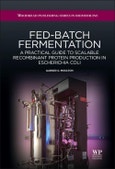Fed-batch Fermentation is primarily a practical guide for recombinant protein production in E. coli using a Fed-batch Fermentation process. Ideal users of this guide are teaching labs and R&D labs that need a quick and reproducible process for recombinant protein production. It may also be used as a template for the production of recombinant protein product for use in clinical trials. The guide highlights a method whereby a medium cell density - final Ods = 30-40 (A600) - Fed-batch Fermentation process can be accomplished within a single day with minimal supervision. This process can also be done on a small (2L) scale that is scalable to 30L or more. All reagents (media, carbon source, plasmid vector and host cell) used are widely available and are relatively inexpensive. This method has been used to produce three different protein products following cGMP guidelines for Phase I clinical studies.
- This process can be used as a teaching tool for the inexperienced fermentation student or researcher in the fields of bioprocessing and bioreactors. It is an important segue from E. coli shake flask cultures to bioreactor- The fed-batch fermentation is designed to be accomplished in a single day with the preparation work being done on the day prior- The fed-batch fermentation described in this book is a robust process and can be easily scaled for CMO production of protein product
Please Note: This is an On Demand product, delivery may take up to 11 working days after payment has been received.
- This process can be used as a teaching tool for the inexperienced fermentation student or researcher in the fields of bioprocessing and bioreactors. It is an important segue from E. coli shake flask cultures to bioreactor- The fed-batch fermentation is designed to be accomplished in a single day with the preparation work being done on the day prior- The fed-batch fermentation described in this book is a robust process and can be easily scaled for CMO production of protein product
Please Note: This is an On Demand product, delivery may take up to 11 working days after payment has been received.
Table of Contents
- List of figures and tables
- Figures
- Tables
- About the author
- 1: Introduction to fermentation
- Abstract
- 1.1 A brief history of early fermentation and the discovery of DNA
- 1.2 The rise of biotechnology I
- 1.3 The rise of biotechnology II
- 2: Generation of a recombinant Escherichia coli expression system
- Abstract
- 2.1 Plasmids
- 2.2 Cloning of foreign gene into plasmid
- 2.3 Transcription of gene into messenger RNA (mRNA)
- 2.4 Host cell
- 2.5 Transformation of E. coli
- 2.6 Making competent cells
- 2.7 Expression screening of transformed host cells
- 2.8 Bacterial growth preparation
- 2.9 Streaking and inoculating plates
- 2.10 Generation of a working cell bank (glycerol stock)
- 3: Recombinant fed-batch fermentation using Escherichia coli
- Abstract
- 3.1 Growth kinetics of E. coli
- 3.2 Reactor kinetics
- 3.3 The bioreactor system
- 3.4 Set-up and performance of a 2 liter fed-batch fermentation
- 3.5 Analysis of fed-batch fermentation
- 3.6 Sample preparation for SDS PAGE
- 4: Escherichia coli produced recombinant protein: Soluble versus insoluble production
- Abstract
- 4.1 Introduction
- 4.2 Translation from RNA into protein
- 4.3 The protein
- 4.4 Soluble protein expression in E. coli
- 4.5 The inclusion body
- 4.6 Isolation and solubilization of inclusion bodies
- 4.7 Ni purification of recombinant protein product
- 4.8 Ni purified protein
- 5: The future of Escherichia coli recombinant fermentation
- Abstract
- References
- Index








